Do you suffer from ankle pain? Ankle pain can have many origins and can easily be put into two main categories. Traumatic vs functional. Traumatic injuries often warrant more immediate imaging and surgery, while functional usually requires a different approach for the problem to truly be corrected. Functional ankle pain is very commonly caused by core and lower leg musculoskeletal imbalances. These are developed over time with poor biomechanics, posture, and habits. In order to understand ankle pain, we must first look to the anatomy for a generalized understanding. A large number of ankle pain cases are actually induced by a lumbopelvic imbalance, but let’s first take a look at the ankle itself.
The ankle is a hinge joint that is comprised of three main bones called the tibia, fibula, and talus. These three bones are supported by a multitude of surrounding ligaments. The main ones being the: the deltoid ligament (comprised of 4 separate ligaments), the anterior talofibular ligament, and the posterior tibiofibular ligament. The ligaments primary goals are to hold the bone together while conforming to the joints normal motion. Ligaments can be easily described as being like a stiffened rubber band. Like with all joints, the surrounding muscles play an integral role as well. These will be more generalized classified for ease of understanding. We have the calf (soleus and gastrocnemius), tibialis anterior, peroneus longus, and tibialis posterior muscles. The foot is comprised of 26 bones and 33 separate joint segments that allow it to absorb shock through the three-point sling system called the arch of the foot. How the arch is structured is extremely vital to how the ankle transfers force. See the diagrams below to better understand the complex anatomy of the ankle:
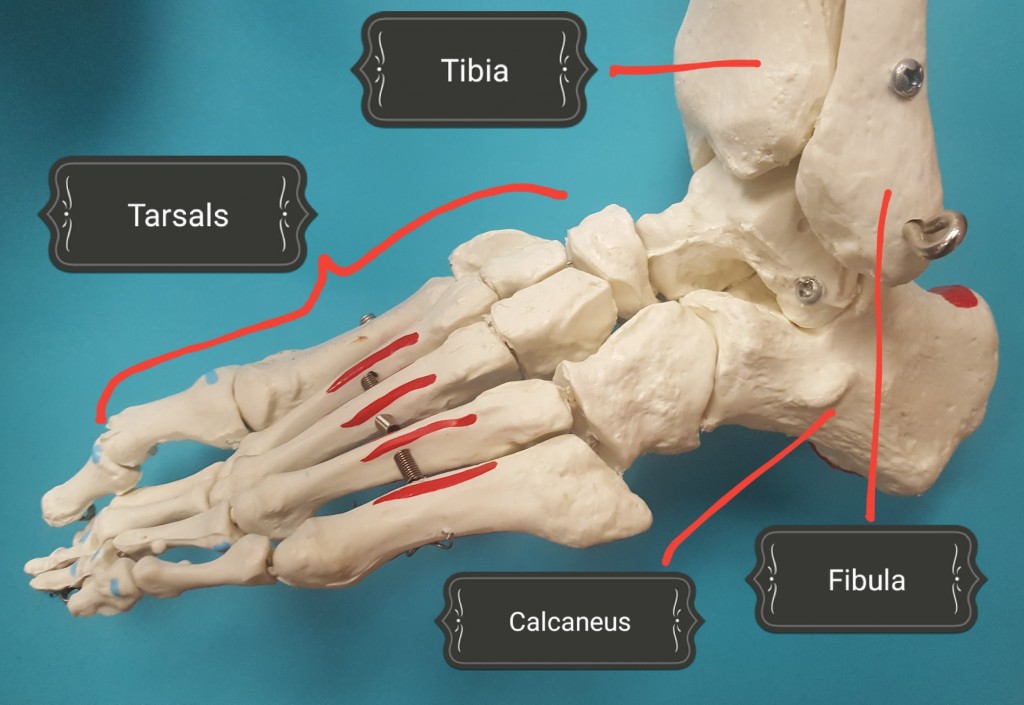

Now that we’ve established a generalized anatomy of the ankle, we can now discuss the specifics of why ankle pain occurs due to the problems in the ankle itself.
- Subluxation- Subluxation is defined in chiropractic as any joint that becomes slightly misaligned or stops moving properly. When the ankle becomes subluxated, nerves become irritated leading to pain.
- Ligamentous weakness or sprain- In addition to the muscles supporting the ankle, there is a multitude of ligaments that help keep the ankle joint in place as well. When these ligaments become weak or injured, it can lead to ankle instability that often leads to a sprained ankle and/or just ankle pain.
- Muscle weakness or injury- The final major cause for ankle pain originating from the ankle itself, is due to problems associated with surrounding musculature. These muscles provide the vast majority of support to the joint in all instances and are responsible for much of the ankle’s movement and range of motion. These muscles can weaken and/or tear over time due to repetitive stress or imbalances that develop over time, leading to pain.
As mentioned before, a large portion of ankle pain actually originates in the lumbopelvic area. The anatomy of the pelvis is also very complex. There are a lot of moving parts and thus many things can go wrong resulting in lumbar or ankle pain. The main reason for ankle specific pain resulting from a lumbopelvic problem is muscular imbalances and nerve irritation from the lumbar nerves. To understand this relationship, we must also look into the anatomy of the lumbar vertebrae, pelvis, and femoral acetabular joints. The lumbar vertebrae all have a cartilaginous disc between them that allow the spine to bend and twist. Also in between each vertebra is a place where nerve roots exit on either side of each vertebra. It is the irritation of these nerve roots which can cause ankle pain. These nerve roots become pinched by misaligned vertebrae or when discs bulge out or even herniate (the disc material leaks out under pressure) putting pressure on the nerve roots that lead to the ankle area, thus causing ankle pain, weakness, or numbness to the area. See the diagram below in order to visualize the lumbar and pelvic anatomy:
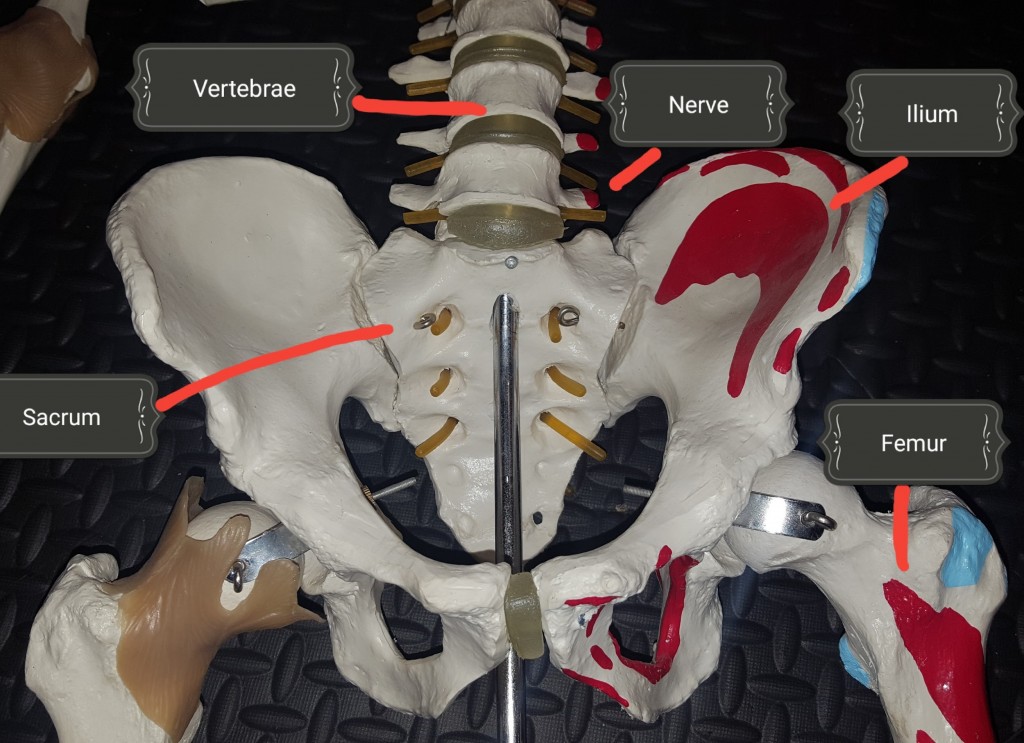
Lumbopelvic muscles are divided into 4 main groups and their function is largely determined by their structural location around the core of the body.
- Flexors – Any muscle located at the front half of the pelvis or lumbar spine is considered a flexor. To envision the action of a flexor, it is the motion of bringing your chest to your knees.
- Extensors- Any muscle located at the back half of the pelvis or lumbar spine is considered an extensor. An extension is performed when arching the lower back.
- Lateral Flexors- Regardless of if they are in front or back of the spine, muscles that are either to the right or left of the spine in the core are the lateral flexors. To envision the motion of the right lateral flexion, for example, imagine sliding your right hand down the side of your thigh.
- Rotators- Muscles that rotate the core can be located in any structural location of the lower back. To envision the action of core rotation, it is simply the act of swinging a bat.
Any muscle of the lower back can belong to more than one functional group listed above. For example, the quadratus lumborum muscle has the ability to extend, laterally flex, and rotate the core.
Now that we have established the anatomy of the lumbar spine and pelvis, we can now discuss the specifics of why ankle pain occurs due to problems throughout the core. Below are the two most common causes:
- Subluxation- As mentioned above in the discussion of the ankle, subluxation is defined in chiropractic as any joint that becomes slightly misaligned or stops moving correctly. The most common type of subluxation in the lower back involves the facet joints. The facet joints are the most posterior joints connecting each of the five lumbar vertebrae. When the facet joints become subluxated it can lead to the irritation of the nerves that extend into the ankle joint causing ankle pain.
- Disc problems – The discs located between each of the vertebrae can bulge and herniate. Located in the center of each disc is a gelatinous material. Over time the walls of the disc can weaken and break down, allowing the gelatinous material to push out or bulge toward the outside of the disc. If the wall breaks and the material actually leaks out, this is called a herniated disc. The problem with a disc bulge or a herniated disc comes when the displaced disc places pressure posteriorly toward the nerve roots that are exiting on either side of the spine at any of the various levels of the vertebrae. This can cause not only lower back pain but also the pain in the ankle as well.
Below are some suggestions for things that you can do for yourself at home to help relieve your ankle pain.
- Apply ice- Many find considerable relief from applying ice to the ankle, Ice works to reduce inflammation and swelling thus providing relief. Apply ice for 15 minutes every 2-3 hours as needed. Simply submerging the ankle in an ice bath for 3-5 minutes is very effective as well. There is a recipe for treating ankle swelling called “RICE.” This stands for rest, ice, compress, and elevate. Compression is often done with ace bandages or a compression sleeve. Elevation means to put the ankle above chest height in order to return blood and lymphatic flow towards the heart at an accelerated rate.
- Watch your sleep – Sleeping on your back is best providing the least amount of stress on the ankles. When sleeping on your back, make sure to keep your feet under a heavy comforter/blanket. This will push the foot down all night and could lead to ankle/foot problems in the future. Sleeping on your side can be done as efficiently if a pillow is placed between the knees and the knees are flexed at an angle of 90 degrees or less. Meaning, you don’t want to be balled up in the “fetal position.”
- Take NSAIDS- Non-steroidal anti-inflammatory drugs like ibuprofen can be taken to reduce swelling in the ankle. By reducing swelling, more space and less irritation is created in the ankle joint, thus allowing for easier mobility and blood flow to the area.
- Stretching- Some simple stretches to help maintain mobility and decrease pain in the ankle are the seated toe touch, the standing Achilles stretch – with your foot propped against a sturdy surface (this can also be done using a towel while seated, see picture below), – and doing the “ABC” ankle rolls. For the ABC ankle roll stretch, you pretend that your big toe is a pen and your “drawing out the alphabet in order” with big swooping ankle movements. You want to reach to the point of “pull or stretch” and don’t want to push it past the point of actual pain.
- Strength exercises-While standing, lift your heels up from the floor and hold your body up, holding for 5 seconds. Do this exercise 10-20 times, for three sessions. This exercise helps to strengthen the posterior chain of the legs. A one-legged stance exercise is also effective for enhancing ankle stability. While standing, take one leg up to 90 degrees and hold for 15-30 seconds while supporting yourself on one leg. Keep a chair, desk, or counter close to avoid the chance of falling. This exercise is also great for enhancing balance and coordination.
- Watch your posture- Many people tend to drag their feet when they walk or sway their weight to one side while standing. Another common mistake is sitting with one foot under your butt cheek. These habits with not only passively strain the tissues around the ankle but also frequently contribute to ankle/foot pain syndromes. If having ankle pain, use the stronger leg to lift yourself upstairs and always use a handrail for stability.
Stretch: Ankle stretch for the Achilles/plantar tendon, soleus, and gastrocnemius muscles.
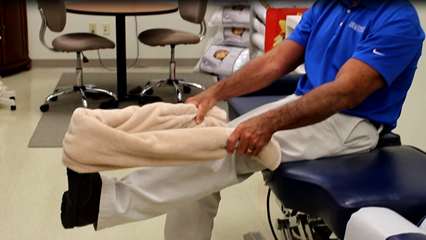
Foot elevation for reducing swelling: Standing calf raise exercise:
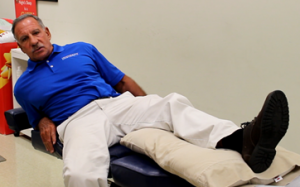
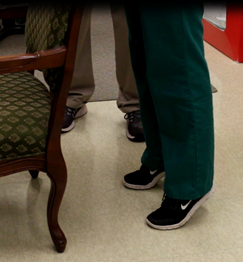
Being a multi-specialty clinic, there are many ways that we can treat ankle pain within our walls.
1. Chiropractic adjustments- Adjustments are able to normalize imbalances in many of the joints of the body including the ankle. By properly aligning the lower back, nerve pressure can be relieved that can elude to ankle pain. Often times, more than one adjustment is necessary to stabilize ankle pain, but many find considerable relief after the first adjustment alone.
2. Physical therapy- Physical therapy is another way we can treat the lower back, pelvis, and ankle in order to decrease ankle pain while improving mobility. The focus of physical therapy is on treating the soft tissue – the muscles, ligaments, tendons, fascia, etc. There is a multitude of services offered by physical therapy in order to treat ankle pain. Some of them include:
- Cryotherapy – cold pack treatment helps reduce inflammation and reduces pain.
- Stretching- stretching helps to loosen tight muscles that are in spasm, thus reducing pain.
- Strengthening- specific exercises can be given to strengthen weak muscles, thus restoring muscular balance to the ankle or lumbopelvic areas.
- Axial decompression- This is a specialized form of treatment typically for the treatment of disc bulges or herniations in the lower back. The patient is placed on a special computerized table that gently and slowly distracts the spine over a 30-minute session. The action of the distraction creates a negative pressure or “vacuum” effect that draws the disc material back inside, thus getting pressure off the nerves that are being compressed in the lower back causing ankle pain.
3. Acupuncture – Acupuncture is an ancient healing art that originated in China over 4000 years ago. The premise of acupuncture is based on meridians (or pathways of energy) that run throughout the body. When a practitioner of acupuncture places needles into the body, they are placing those needles on key points along those meridians in order to manipulate that energy to promote healing in that area of the body. Treatment typically takes about 20 minutes to complete and is painless. Acupuncture is very effective for treating ankle pain and restoring the overall function of the body.
4. Family Medicine- At Health Quest we emphasize conservative care with drugs and surgery as the last resort when possible. But sometimes, if you are in extreme pain, it is necessary to have a little help to get you through. In extreme cases, medicine could be prescribed to help get you through the pain in the short term.
5. Massage- Often ankle pain is the result of tight muscles. Or sometimes the tight muscles might result from having the ankle pain. Either way, ankle pain can be relieved with a massage by relaxing muscles, increasing blood flow to help speed up healing and flush out toxins in the local soft tissue.
If you or someone you know is suffering from ankle pain, we may be able to help you at Health Quest through chiropractic, physical therapy, massage, acupuncture, or family medicine. At Health Quest, we are committed to helping you meet your health goals and leading you to a healthy and pain-free lifestyle. Call us today to schedule an evaluation at 573-635-9655.
Yours in health,
Dr. Brandon Lehr D.C.

